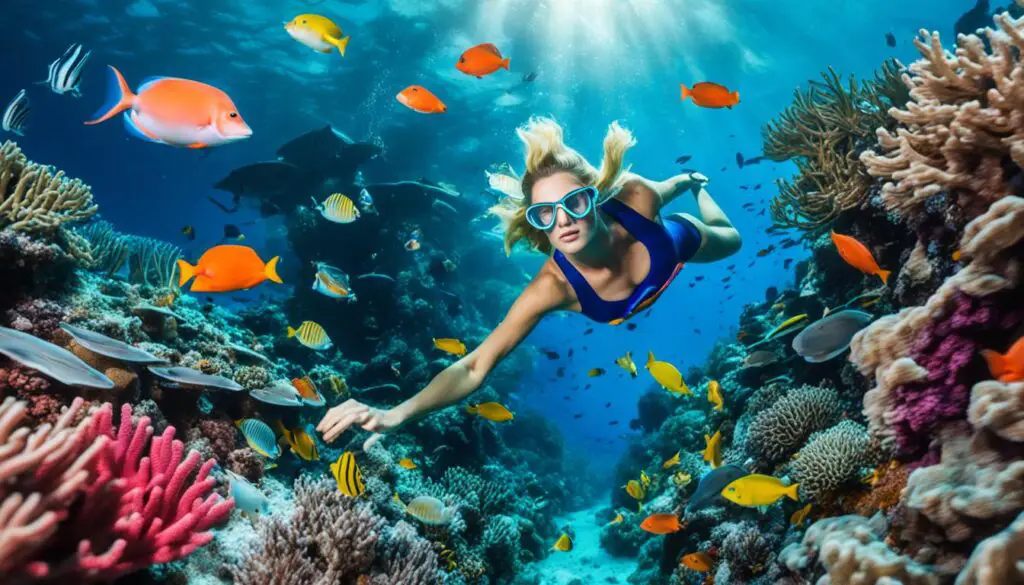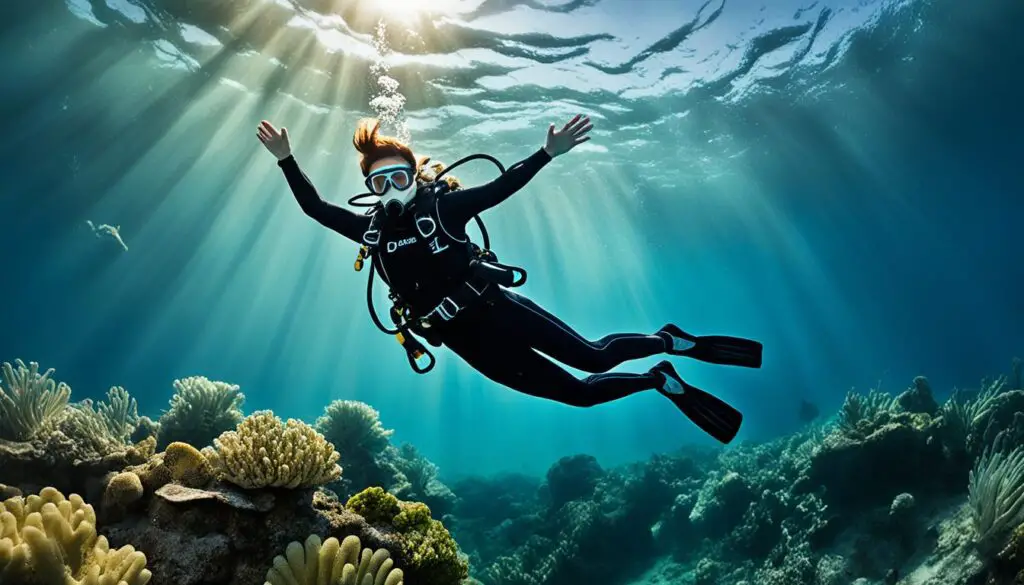In the mesmerizing realm of underwater photography, capturing the perfect shot requires more than just technical skills and equipment. It’s an art that requires careful consideration of every element, including the poses of the subjects. Underwater photography poses have the power to transform aquatic shoots with grace and fluidity, adding a touch of elegance to every image.
When done right, underwater photography poses can elevate the overall composition and aesthetics of the image. They allow the subject to become one with the water, creating a sense of harmony and beauty that captivates the viewer. The right pose can convey a story, evoke emotions, and emphasize the inherent gracefulness of the underwater world.
In this section, I will delve into the importance of underwater photography poses and provide essential tips and techniques for mastering them. Whether you’re a professional photographer or an enthusiast looking to improve your skills, these insights will help you capture captivating shots that truly showcase the beauty of aquatic life.
Key Takeaways:
- Underwater photography poses add grace and fluidity to aquatic shoots.
- The right pose can elevate the overall composition and aesthetics of the image.
- Underwater photography poses allow the subject to become one with the water, creating harmony and beauty.
- Mastering underwater photography poses requires practice and attention to detail.
- By following the tips and techniques provided, you can capture captivating shots that showcase the beauty of aquatic life.
The Art of Underwater Poses: Techniques for Captivating Shots
In the world of underwater photography, mastering the art of capturing captivating shots requires more than just a keen eye and a skilled hand. It involves understanding the techniques that can elevate your underwater photography poses to new heights. By utilizing specific poses and employing various techniques, you can create dynamic and visually appealing images that engage your audience.
Body positioning plays a crucial role in underwater photography. It helps convey a sense of grace and fluidity, enhancing the overall composition of your shots. Whether it’s arching your back to create elegant curves or extending your limbs to create a sense of freedom, the right body position can transform an ordinary photograph into a stunning work of art.
Facial expressions also play a significant role in capturing captivating shots underwater. The water’s distortion can alter the appearance of your facial features, so it’s important to exaggerate your expressions to convey the desired emotions. Smizing (smiling with your eyes) or exuding a sense of tranquility can add depth and intrigue to your photographs, drawing viewers into the underwater world you’ve created.
“Underwater photography poses have the unique ability to evoke emotions and tell stories that words simply can’t. By mastering these techniques, you can create captivating shots that leave a lasting impression on your audience.”
Hand gestures are another essential element in underwater photography poses. They can add movement, elegance, and a sense of interaction to your shots. Whether it’s gracefully reaching towards the surface or delicately touching the marine life around you, hand gestures can bring a sense of life and connection to your underwater images.
Exploring different types of poses can also breathe life into your underwater photography. Floating on the water’s surface and allowing your body to merge with the surrounding elements can create a sense of tranquility. Diving deeper and capturing the play of light and shadows can produce dramatic and mysterious shots. Interacting with marine life, such as swimming alongside dolphins or observing vibrant coral reefs, can add a touch of wonder and enchantment to your underwater compositions.
Mastering Underwater Photography Poses: Step-by-Step Guide
- Start by practicing in a controlled environment, such as a pool, to familiarize yourself with buoyancy and the challenges of underwater photography poses.
- Experiment with different body positions and observe how they affect the overall composition of your shots.
- Focus on your facial expressions, exaggerating them to convey the desired emotions that complement your underwater theme.
- Experiment with hand gestures, exploring how they can add movement and elegance to your compositions.
- Gradually venture into open water, taking safety precautions and using proper equipment to ensure a successful and safe underwater photoshoot.
By implementing these techniques and mastering the art of underwater photography poses, you can create captivating shots that mesmerize your audience and tell compelling stories beneath the surface.

| Technique | Description |
|---|---|
| Body Positioning | Utilize body language to convey grace, fluidity, and enhance the overall composition of your shots. |
| Facial Expressions | Exaggerate facial expressions to convey emotions and create depth and intrigue in your photographs. |
| Hand Gestures | Add movement, elegance, and interaction to your shots through deliberate and purposeful hand gestures. |
| Exploring Different Types of Poses | Experiment with floating, diving, and interacting with marine life to add variety and wonder to your underwater compositions. |
Overcoming Challenges: Tips for Successful Underwater Poses
Mastering underwater poses in photography presents a unique set of challenges that require careful consideration and preparation. In this section, I will share practical tips and techniques to help you overcome these obstacles and achieve successful underwater poses. From buoyancy control to communication and equipment handling, these tips will ensure a smooth and productive underwater photoshoot.
Buoyancy Control
Buoyancy control is essential for executing graceful underwater poses. Maintaining neutral buoyancy allows you to control your position and movement effortlessly. To achieve this, consider the following tips:
- Practice proper weighting: Adjust your weight system to achieve neutral buoyancy, allowing you to stay at the desired depth without floating up or sinking.
- Control your breathing: Slow, deep breaths help maintain buoyancy and prevent sudden movements that can disrupt your pose.
- Use underwater props: Holding onto underwater props, such as rocks or corals, can provide stability and assist with maintaining balance.
Communication
Effective communication is crucial between the photographer and the model to achieve the desired underwater poses. Consider the following communication techniques:
- Establish clear signals: Agree on a set of hand signals or non-verbal cues that both the model and photographer understand. This ensures smooth communication during the photoshoot.
- Practice in advance: Before the actual shoot, rehearse the signals and practice understanding each other’s movements to establish a solid communication rhythm.
- Use underwater communication devices: If feasible, invest in underwater communication devices, such as underwater speakers or specially designed masks, to facilitate real-time communication.
Equipment Handling
Handling photography equipment underwater requires skill and caution. Here are some tips to ensure the safety of your equipment and achieve successful underwater poses:
- Invest in waterproof gear: Use a waterproof camera housing or an underwater camera designed for such shoots to protect your equipment from water damage.
- Secure your gear: Use straps and lanyards to secure your equipment to your body or a stable surface to prevent accidental loss or damage.
- Proper maintenance and cleaning: Rinse your equipment thoroughly with fresh water after each use to remove salt and debris, and regularly check for any signs of wear or damage.
By following these tips and overcoming the inherent challenges of underwater poses, you’ll be well on your way to creating stunning underwater photography. Now, let’s move on to the final section, where I will summarize the key points and offer some concluding thoughts on mastering the art of underwater photography poses.
Common Challenges in Underwater Poses and Tips to Overcome Them
| Challenges | Tips |
|---|---|
| Buoyancy control | Practice proper weighting Control breathing Use underwater props |
| Communication | Establish clear signals Practice in advance Use underwater communication devices |
| Equipment handling | Invest in waterproof gear Secure your gear Proper maintenance and cleaning |

Conclusion
Mastering the art of underwater photography poses is the key to elevating the quality and impact of your aquatic shoots. By understanding the significance of striking the right pose, employing various techniques to capture captivating shots, and overcoming common challenges, you can take your underwater photography to new heights.
Underwater photography poses are not just about posing for the camera; they are about creating dynamic compositions that showcase the grace and fluidity of the underwater world. By practicing these poses and developing a keen eye for detail, you’ll be able to create stunning images that truly capture the beauty of this unique environment.
However, mastering underwater photography poses requires more than just technical skill. It also requires patience, perseverance, and a willingness to experiment. Don’t be afraid to try new poses, explore different angles, and push the boundaries of your creativity. With time and practice, you’ll develop your own style and master the art of underwater photography poses.
So dive in, embrace the challenges, and start mastering those underwater poses today. The underwater world is waiting to be captured through your lens, and by perfecting your poses, you’ll be able to create images that truly elevate your shoots to a whole new level.
FAQ
How important are underwater photography poses for aquatic shoots?
Underwater photography poses are crucial for aquatic shoots as they bring grace and fluidity to the images, enhancing the overall composition and aesthetics.
What techniques can I use to capture captivating underwater shots?
To capture captivating underwater shots, focus on body positioning, facial expressions, and hand gestures. These elements help create dynamic and visually appealing images.
What types of poses should I master for underwater photography?
It’s important to master various poses such as floating, diving, and interacting with marine life to add variety and interest to your underwater photography portfolio.
What are the common challenges in underwater photography poses, and how can I overcome them?
Common challenges include buoyancy control, communication, and equipment handling. Overcome them by practicing proper techniques, improving communication with your team, and ensuring you have the necessary equipment.
How can I ensure a successful underwater photoshoot?
Safety and proper preparation are key to a successful underwater photoshoot. Prioritize safety protocols, plan your shoot meticulously, and familiarize yourself with the shoot location beforehand.
